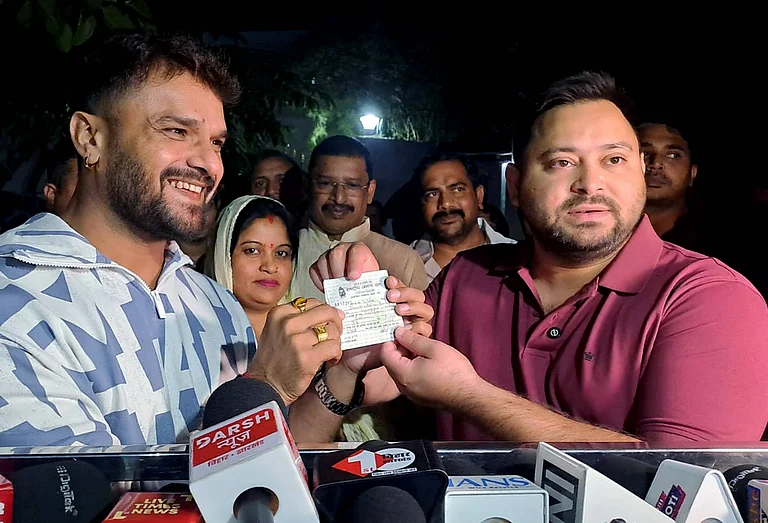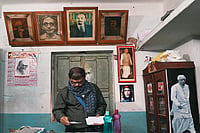
A folk tradition popular in Bhojpur regions, Launda Naach is usually performed at auspicious occasions
Samrat Choudhary passed jibes at Khesari Lal Yadav for being a Launda Naach performer
A political party that earns its currency from glorifying the country’s history must hold reverence for art forms that have put the country on the global map of aesthetic traditions
Launda Naach is a folk theatre tradition that was popularized by Bhikhari Thakur, a Bihari playwright and folk performer, often known as the “Shakespeare of Bhojpuri”. This folk tradition is practised in the Bhojpur region of Bihar and Purvanchal (Eastern End of Uttar Pradesh and parts of Western Bihar). It is not only a dance form, but a composite mixture of music, dance, humor, dialogues and melodrama, expressing a whole range of emotions and nuanced storytelling. It also involves female impersonation by men and is performed at auspicious occasions like marriage and childbirth.
Recently, Bhojpuri actor and singer Khesari Lal Yadav, who is contesting in the Bihar elections from Chapra, got mocked by opposing leader Samrat Choudhary for being a Launda Naach performer. But if his movements or garb appear odd or demeaning to the beholder, it is also possible that much of this poisonous attitude springs from misogyny and homophobia—currently permeating the collective consciousness of Indian politics and society—and the notion that the worst thing a man can do is to emulate what is perceived as exclusively female behavior. May be Khesari Lal is truly comfortable as an artist and in touch with his feminine side. It is possible that as an artist, he comes alive with dance, and is in touch with his most authentic self.

What is surprising about the comments made by Choudhary against Yadav is that they come during the elections of a state that is well-known for producing artists like Bhikhari Thakur.
When the lack of education and employment leaves young men with very few options, many of the Launda performers take up this profession to make a living and once in, they are labelled for life, just as one can see happening with Yadav. In a curious reversal of gender discrimination, the male dancer leads a second-class existence. Furthermore, the very scope of this performance is colored by its associations with subordinated castes. At its root is the social shame associated with dancing as also its association with lower class communities.
Ironically, through these performances, these men belonging to subordinated castes assert their agency, justifying the popular saying, ‘Naachkaanchhai, baatsachhai’ (Naach is the mirror that reflects the truth of society).
When we mock men who dance, it is a combination of social norms, perceived awkwardness, and amusement at a departure from expectations, as dance is often culturally coded as a skill men have less aptitude for. But this says less about the men dancing and more about the ones calling them ‘nachaniyas’, such as Choudhary. BJP leader Manoj Tiwari defended Choudhary and said the viral clip was AI-generated, adding that NDA respects all its artist members and avoids using derogatory terms.
However, what becomes important to question in this context is why the term ‘nachaniya’ must be seen as derogatory in the first place. India has a long, diverse and culturally rich history of folk theatre traditions, in which Launda naach has a significant place. If anything, a political party that earns its currency from glorifying the country’s history must hold reverence for art forms that have put the country on the global map of aesthetic traditions. At least, there are many examples of films that have consistently represented this tradition within its complex socio-cultural context.
The Lipstick Boy (2023) by Abhinav Thakur depicts the journey of a real life artist, a Launda dancer Kumar Uday Singh and artists like him from Bihar, with a prologue voiced by Amitabh Bachchan. Even today, there are many such artists in Bihar who are keeping this form of dance alive.

In 2024’s Naach Basanti Naach, Launda dancer Basant hides his profession from his girlfriend and his dance troupe faces attacks from the village head. His double life, when discovered by his love, also leads to conflict.
The dance has also entered mainstream consciousness with Anurag Kashyap’s Gangs of Wasseypur 2 (2012) featuring a scene with a Launda Naach. In the film Naach Baiu Naach (2022), a man is greeted with claps and whistles when he plays Launda Naach Natua (a man impersonating a woman) on stage. However, when he comes back to his original appearance, he is jeered and rebuked by the same society
There are also documentaries exploring the lives of Launda Naach performers, such as Naach Bhikhari Naach (2019), in which, as the protagonists narrate their life stories, they provide an insight into the politics and aesthetics of the works of artists like Thakur.
Launda Naach could be the equivalent of male drag artists in western culture and depending on how you look at it, it could be both a subversion of traditional masculinity, or a cruel parody of a hackneyed and stereotypical vision of female beauty. Even in the west, men are ridiculed and demeaned for choosing to dance, particularly ballet. In India, men may become dance teachers, or provide musical accompaniment to women who dance, but if they themselves don sarees or ghunghroos and start to dance, they are put down as effeminate upstarts in a female domain. This is paradoxical, considering Nataraja (another name for the Hindu god Shiva), the patron deity of dancers and the king of performers, is a male, and according to scriptures, the originator of dance.
In Yadav’s words while referring to his political ideology and goals, “Anyone can do the easy thing.” Is dance then, a way of showing his people that he is willing to do the hard thing, by putting himself out there?



























